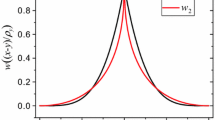Abstract
This paper is concerned with the modeling of heterogeneous materials with uncertain inclusion geometry. The eXtended stochastic finite element method (X-SFEM) is a recently proposed approach for modeling stochastic partial differential equations defined on random domains. The X-SFEM combines the deterministic eXtended finite element method (XFEM) with a polynomial chaos expansion (PCE) in the stochastic domain. The X-SFEM has been studied for random inclusion problems with a \(C^0\)-continuous solution at the inclusion interface. This work proposes a new formulation of the X-SFEM using the Heaviside enrichment for modeling problems with either continuous or discontinuous solutions at the uncertain inclusion interface. The Heaviside enrichment formulation employs multiple enrichment levels for each material subdomain which allows more complex inclusion geometry to be accurately modeled. A PCE is applied in the stochastic domain, and a random level set function implicitly defines the uncertain interface geometry. The Heaviside enrichment leads to a discontinuous solution in the spatial and stochastic domains. Adjusting the support of the stochastic approximation according to the active stochastic subdomain for each degree of freedom is proposed. Numerical examples for heat diffusion and linear elasticity are studied to illustrate convergence and accuracy of the scheme under spatial and stochastic refinements. In addition to problems with discontinuous solutions, the Heaviside enrichment is applicable to problems with \(C^0\)-continuous solutions by enforcing continuity at the interface. A higher convergence rate is achieved using the proposed Heaviside enriched X-SFEM for \(C^0\)-continuous problems when compared to using a \(C^0\)-continuous enrichment.

















Similar content being viewed by others
References
Fernández-Méndez S, Huerta A (2004) Imposing essential boundary conditions in mesh-free methods. Comput Methods Appl Mech Eng 193:1257–1275
Fries TP, Belytschko T (2010) The extended/generalized finite element method: an overview of the method and its applications. Int J Numer Methods Eng 84:253–304
Hampton J, Doostan A (2015) Coherence motivated sampling and convergence analysis of least-squares polynomial chaos regression. Comput Methods Appl Mech Eng 290:73–97
Hansbo A, Hansbo P (2004) A finite element method for the simulation of strong and weak discontinuities in solid mechanics. Comput Methods Appl Mech Eng 193:3523–3540
Juntunen M, Stenberg R (2009) Nitsche’s method for general boundary conditions. Math Comput 78:1353–1374
Lang C, Doostan A, Maute K (2013) Extended stochastic FEM for diffusion problems with uncertain material interfaces. Comput Mech 51:1031–1049
Lang C, Makhija D, Doostan A, Maute K (2014) A simple and efficient preconditioning scheme for heaviside enriched XFEM. Comput Mech 54:1357–1374
Makhija D, Maute K (2014) Numerical instabilities in level set topology optimization with the extended finite element method. Struct Multidiscip Optim 49:185–197
Makhija D, Maute K (2015) Level set topology optimization of scalar transport problems. Struct Multidiscip Optim 51:267–285
Moës N, Dolbow J, Belytschko T (1999) A finite element method for crack growth without remeshing. Int J Numer Methods Eng 46:131–150
Nouy A, Clément A (2010) Extended stochastic finite element method for the numerical simulation of heterogeneous materials with random material interfaces. Int J Numer Methods Eng 83:1312–1344
Nouy A, Schoefs F, Moës N (2007) X-SFEM, a computational technique based on X-FEM to deal with random shapes. Eur J Comput Mech 16:277–293
Nouy A, Clément A, Schoefs F, Moës N (2008) An extended stochastic finite element method for solving stochastic partial differential equations on random domains. Comput Methods Appl Mech Eng 197:4663–4682
Savvas D, Stefanou G, Papadrakakis M, Deodatis G (2014) Homogenization of random heterogeneous media with inclusions of arbitrary shape modeled by xfem. Comput Mech 54:1221–1235
Sethian J (1999) Level set methods and fast marching methods: evolving interfaces in computational geometry, fluid mechanics, computer vision, and materials science. Cambridge University Press, New York
Stefanou G (2009) The stochastic finite element method: past, present, and future. Comput Methods Appl Mech Eng 198:1031–1051
Stefanou G, Nouy A, Clément A (2009) Identification of random shapes from images through polynomial chaos expansion of random level set functions. Int J Numer Methods Eng 79:127–155
Stenberg R (1995) On some techniques for approximating boundary conditions in the finite element method. J Comput Appl Math 63:139–148
Sukumar N, Chopp D, Moës N, Belytschko T (2001) Modeling holes and inclusions by level sets in the extended finite element method. Comput Methods Appl Mech Eng 190:6183–6200
Tan L, Zabaras N (2006) A level set simulation of dendritic solidification with combined features of front-tracking and fixed-domain methods. J Comput Phys 211:36–63
Terada K, Asai M, Yamagishi M (2003) Finite cover method for linear and non-linear analyses of heterogeneous solids. Int J Numer Methods Eng 58:1321–1346
Wan X, Karniadakis G (2006) Multi-element generalized polynomial chaos for arbitrary probability measures. SIAM J Sci Comput 28:901–928
Wang M, Wang X, Guo D (2003) A level set method for structural topology optimization. Comput Methods Appl Mech Eng 192:227–246
Xiu D (2010) Numerical methods for stochastic computations: a spectral method approach. Princeton University Press, Princeton
Xiu D, Karniadakis G (2002) The Wiener–Askey polynomial chaos for stochastic differential equations. SIAM J Sci Comput 24:619–644
Acknowledgments
The first author acknowledges the support of the NASA Fundamental Aeronautics Program Fixed Wing Project, and the second, third, and fourth author acknowledges the support of the National Science Foundation under Grant CMMI-1201207. The third author acknowledges the support of the U.S. Department of Energy Office of Science, Office of Advanced Scientific Computing Research, under Award Number DE-SC0006402 and the National Science Foundation under Grant CMMI-1454601. The opinions and conclusions presented are those of the authors and do not necessarily reflect the views of the sponsoring organizations.
Author information
Authors and Affiliations
Corresponding author
Rights and permissions
About this article
Cite this article
Lang, C., Sharma, A., Doostan, A. et al. Heaviside enriched extended stochastic FEM for problems with uncertain material interfaces. Comput Mech 56, 753–767 (2015). https://doi.org/10.1007/s00466-015-1199-1
Received:
Accepted:
Published:
Issue Date:
DOI: https://doi.org/10.1007/s00466-015-1199-1




